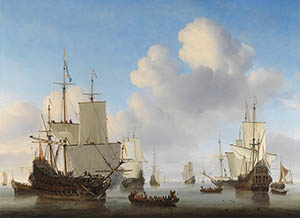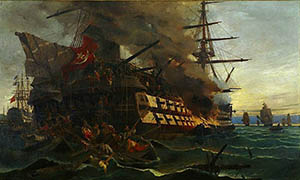History of war risks insurance
 They were therefore covered by marine insurance which offered protection for maritime trade against war risks in the same way as fire or other hazards of the sea. This coverage had then been ranking high in the economy of the 18th and 19th centuries.
They were therefore covered by marine insurance which offered protection for maritime trade against war risks in the same way as fire or other hazards of the sea. This coverage had then been ranking high in the economy of the 18th and 19th centuries.
Relatively recent, the distinction between war risk and sea risk is the result of a long evolution over the centuries. During the 17th, 18th and 19th centuries and until 1967, there was no regulatory difference between the two types of risk.
At the market level, it is only from 1840 onwards that insurers started to introduce modifications in their policies, with war risks no longer automatically covered.
The notion of war risk has thus evolved over the centuries in order to adapt to the times and the inherent risks.
Another evolution, introduced at the beginning only in the marine transport policies, the war risk guarantee was then extended to property and life insurance.
From an ordinary risk, this hazard is now considered as an extraordinary risk which is covered by private insurers as well as by public authorities.
Birth of the notion of war risk in the 17th century
The notion of war risks emerged in the middle of the 17th century in a confused historical context, coupled with numerous conflicts in Europe, along the Mediterranean rim and the main marine routes.
During the 17th century, geographical expansions towards new lands (United States) and commercial explorations towards India and the Far East were in full swing. This expansionism led to confrontations, mainly naval, on the Mediterranean, oceanic, Atlantic and Indian sea routes.
The risks of war were very much feared. They were specifically mentioned in all marine hull and cargo insurance contracts drawn up in the main coastal marine centers of England, France, Italy, the Netherlands, etc.
The perils of the sea pertained to the risks of loss or damage, changes of route or ship. War risks were considered as normal risks, back then.
In France, the main legislation governing marine activity back then was the "Colbert's Ordinance" (1). Published in 1681, this provision introduced a rule including war risks in the coverage of marine insurance companies under the same conditions as sea risks.
(1) Founding text of French maritime law
War risks insurance in the 18th century
Lloyd's, a historical player in the marine transport market, introduced war risk coverage in its insurance policies as early as 1779.
In its standard form, the contract listed fifteen different marine perils, eleven of which were specifically related to war, piracy and violence on the high seas.
War risks insurance in the 19th century
 By the middle of the 19th century, wars became less frequent. Contractual relationships between insurers and shipowners started to be re-examined.
By the middle of the 19th century, wars became less frequent. Contractual relationships between insurers and shipowners started to be re-examined.
This century, marking a change in the relationship between insurers and shipowners, was characterized by:
- a relative calm at sea,
- an increase in the value of ships,
- the enactment of legislation governing maritime trade.
In France, one of the main maritime powers of that era, we note the promulgation in 1807 of the Commercial Code, a document introducing a profound overhaul of maritime regulatory texts. It indiscriminately characterized war and marine risks as a sea fortune.
A single marine contract, therefore, covered all events likely to affect the ship and its cargo during the voyage, whether these events were the result of an accident at sea, an act or fact of war.
In a new development, as early as 1840, French insurers managed to reach a compromise with shipowners and clients to progressively exclude war risks from ordinary policies. They then agreed to cover these risks through special agreements.
In England, the leading marine power of the 19th century, Lloyd's modified its standard contract SG Form (1) (Ship and Goods Form) in 1898. War risks, excluded from standard marine policies, became covered by a specific clause: F. C. & S. (Free of Capture and Seizure Clause).
In the face of legislative stagnation, insurers' practices continue to evolve. The major maritime risk markets such as Paris, London and Genoa are gradually modifying their general underwriting conditions. From now on, war risks are no longer systematically covered by insurers, with additional premiums being introduced for coverage in the event of war.
Insurers justify their position by:
- the decline in conflicts and acts of war,
- the expensive cost of ships,
- the increase in the value of transported goods,
- increased exposure to risk.
(1) Lloyd's SG Form covered all risks without distinction.
War risks insurance in the 20th century
 The 20th century was marked by two world wars which had a profound impact on the coverage of war risks.
The 20th century was marked by two world wars which had a profound impact on the coverage of war risks.
This period was characterized by:
- the enactment of new legislation,
- the brokering of inter-company agreements,
- the exclusion of war risks,
- the involvement of public authorities.
Faced with risks that are difficult to insure because of the level of losses generated during armed conflicts, the insurance markets adopt a more or less identical approach.